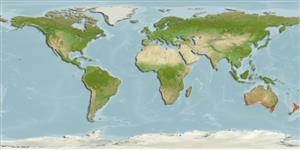Actinopterygii (ray-finned fishes) >
Perciformes (Perch-likes) >
Cheilodactylidae (Morwongs)
Etymology: Nemadactylus: Greek, nema, -atos = filament + Greek, daktylos = finger (Ref. 45335).
Environment / Climate / Range
Ecology
Marine; demersal; depth range 0 - 200 m (Ref. 89422), usually 10 - 100 m (Ref. 9563). Temperate, preferred ?; 27°S - 44°S
Southwest Pacific: Australia, New Zealand and the Kermadec Islands.
Size / Weight / Age
Maturity: Lm ? range ? - ? cm
Max length : 81.0 cm FL male/unsexed; (Ref. 89422); max. published weight: 4.0 kg (Ref. 26498)
Occurs on the continental shelf, commonly near reefs (Ref. 26998, 9563). Feed mainly on invertebrates (Ref. 26998). Marketed fresh and frozen; eaten steamed, pan-fried, broiled and baked (Ref. 9988). Seen in small aggregations but school in deep water where commercially trawled (Ref. 9002).
Life cycle and mating behavior
Maturity | Reproduction | Spawning | Eggs | Fecundity | Larvae
May, J.L. and J.G.H. Maxwell, 1986. Trawl fish from temperate waters of Australia. CSIRO Division of Fisheries Research, Tasmania. 492 p. (Ref. 9563)
IUCN Red List Status (Ref. 115185)
CITES (Ref. 94142)
Not Evaluated
Threat to humans
Harmless
Human uses
Fisheries: minor commercial
More information
Common namesSynonymsMetabolismPredatorsEcotoxicologyReproductionMaturitySpawningFecundityEggsEgg development
Tools
Special reports
Download XML
Internet sources
Estimates of some properties based on models
Phylogenetic diversity index (Ref.
82805): PD
50 = 0.5078 [Uniqueness, from 0.5 = low to 2.0 = high].
Trophic Level (Ref.
69278): 3.4 ±0.3 se; Based on diet studies.
Resilience (Ref.
69278): Very Low, minimum population doubling time more than 14 years (Preliminary K or Fecundity.).
Vulnerability (Ref.
59153): High to very high vulnerability (66 of 100) .
